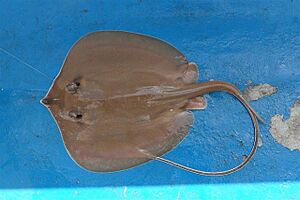Daisy stingray facts for kids
Quick facts for kids Daisy stingray |
|
|---|---|
 |
|
| Conservation status | |
| Scientific classification | |
| Genus: |
Fontitrygon
|
| Species: |
margarita
|
| Synonyms | |
|
|
The daisy stingray (Fontitrygon margarita) is a type of stingray. It lives in the shallow waters along the coast of West Africa. This stingray can grow to about 60 cm (24 inches) wide. It has a round body and a special "pearl spine" on its back. This spine is a large, shiny bump that looks like a pearl.
Daisy stingrays mainly eat crustaceans, like crabs and shrimp. They give birth to live young, usually 1 to 4 pups at a time. Sadly, the daisy stingray is becoming rare. This is because of fisheries (people catching them) and changes to their habitat. The International Union for Conservation of Nature (IUCN) says it is a "Vulnerable" species.
Contents
Meet the Daisy Stingray
How the Daisy Stingray Got Its Name
A British zoologist named Albert Günther first described the daisy stingray in 1870. He called it Trygon margarita. Later, scientists changed its genus name to Dasyatis and then Fontitrygon.
The name margarita comes from the Latin word for "pearl". This name was chosen because of the large, pearl-like bump on its back. This special feature helps identify the daisy stingray.
Similar Stingrays
The daisy stingray looks a lot like another stingray called the pearl stingray (F. margaritella). The pearl stingray is much smaller. For a long time, people often confused these two species. Scientists had to study them closely to tell them apart.
Where Daisy Stingrays Live
Their Ocean Home
Daisy stingrays are found along the coast of West Africa. Their known range stretches from Senegal all the way to the Democratic Republic of the Congo. Some reports say they might live as far north as Mauritania and as far south as Angola. However, these reports might have been about the smaller pearl stingray.
Preferred Habitats
This stingray is a bottom-dwelling animal. This means it lives on the seafloor. It likes sandy areas in shallow coastal waters. You can usually find them in depths up to 60 meters (200 feet). Most are found between 11 and 20 meters (36 and 66 feet) deep.
They can live in both salty ocean water and brackish water. Brackish water is a mix of fresh and saltwater, like in lagoons and estuaries. However, scientists are still checking if they truly use these areas, again because of confusion with the pearl stingray.
What Daisy Stingrays Look Like
Body Shape and Size
The daisy stingray has a thin, rounded body disc. It's about as wide as it is long. The front edges of its body curve inward, leading to a slightly pointed snout. Its eyes are medium-sized, and behind them are two breathing holes called spiracles.
Inside its mouth, there are small bumps called papillae. It has many rows of teeth, like a pavement, to help it crush its food. The daisy stingray can grow up to 1 meter (3.3 feet) wide and weigh up to 17 kg (37 pounds). However, most are usually around 60 cm (24 inches) wide. Female daisy stingrays tend to grow larger than males.
The Pearl Spine and Skin
The most unique feature is the large, round "pearl spine" in the middle of its back. Young daisy stingrays have smooth skin. But as they get older (over 20 cm wide), they develop a wide band of small, flat, round bumps called dermal denticles. These cover the middle of their back, from between their eyes to the base of their tail.
The daisy stingray is usually grayish-brown on top and whitish underneath. Its tail is longer than its body. It usually has one long, thin stinging spine on top. The tail is wide at the base and becomes thin like a whip after the spine.
How to Tell it Apart from the Pearl Stingray
Besides being much larger, the daisy stingray has a bigger, rounder pearl spine. It also has fewer rows of teeth and more bones in its pectoral fins. These small differences help scientists tell the two similar species apart.
Life and Habits of the Daisy Stingray
What They Eat
Not much is known about the daily life of the daisy stingray. We do know that they mainly eat shrimp, crabs, bivalves (like clams), and annelid worms. Off the coast of Nigeria, about three-quarters of their diet is a type of shrimp called Farfantepenaeus duorarum.
How They Reproduce
Like other stingrays, the daisy stingray gives birth to live young. This is called aplacental viviparity. Females usually have litters of 1 to 4 pups. They often use coastal lagoons and estuaries as safe places to have their babies.
Reproduction is busiest during the rainy season, from April to September. This is probably when there is a lot of food available for the new pups.
Daisy Stingrays and Humans
Safety and Fishing
The tail spine of the daisy stingray is said to be very venomous. It can cause injury to humans.
People catch daisy stingrays for food. They are caught by small-scale commercial and artisanal fishers in places like Senegal, Ghana, and Côte d'Ivoire. The stingrays are sold fresh, smoked, or dried and salted. Fishermen use many different tools to catch them, including longlines, bottom trawls, trammel nets, gillnets, traps, beach seines, and hook-and-line.
Threats and Conservation
Besides fishing, the daisy stingray's home is also being harmed. Habitat degradation happens when pollution from farms (agricultural runoff) and factories damages their living areas.
This stingray reproduces slowly, and catches have become rare recently. Because of these threats, the International Union for Conservation of Nature (IUCN) has listed the daisy stingray as "Vulnerable." This means it is at risk of becoming endangered. So far, there are no specific plans to protect the daisy stingray.


